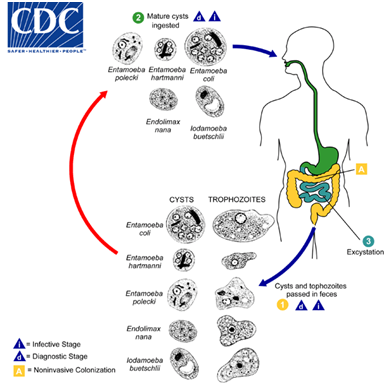Entamoeba polecki on:
[Wikipedia]
[Google]
[Amazon]
''Entamoeba polecki'' is an intestinal

parasite
Parasitism is a close relationship between species, where one organism, the parasite, lives on or inside another organism, the host, causing it some harm, and is adapted structurally to this way of life. The entomologist E. O. Wilson has ...
of the genus ''Entamoeba
''Entamoeba'' is a genus of Amoebozoa found as internal parasites or commensals of animals.
In 1875, Fedor Lösch described the first proven case of amoebic dysentery in St. Petersburg, Russia. He referred to the amoeba he observed microscopic ...
''. ''E. polecki'' is found primarily in pigs and monkeys and is largely considered non-pathogenic in humans, although there have been some reports regarding symptomatic infections of humans. Prevalence is concentrated in New Guinea
New Guinea (; Hiri Motu
Hiri Motu, also known as Police Motu, Pidgin Motu, or just Hiri, is a language of Papua New Guinea, which is spoken in surrounding areas of Port Moresby (Capital of Papua New Guinea).
It is a simplified version of ...
, with distribution also recorded in areas of southeast Asia
Asia (, ) is one of the world's most notable geographical regions, which is either considered a continent in its own right or a subcontinent of Eurasia, which shares the continental landmass of Afro-Eurasia with Africa. Asia covers an area ...
, France
France (), officially the French Republic ( ), is a country primarily located in Western Europe. It also comprises of Overseas France, overseas regions and territories in the Americas and the Atlantic Ocean, Atlantic, Pacific Ocean, Pac ...
, and the United States
The United States of America (U.S.A. or USA), commonly known as the United States (U.S. or US) or America, is a country primarily located in North America. It consists of 50 states, a federal district, five major unincorporated territorie ...
.
Morphology
Maturetrophozoites A trophozoite (G. ''trope'', nourishment + ''zoon'', animal) is the activated, feeding stage in the life cycle of certain protozoa such as malaria-causing '' Plasmodium falciparum'' and those of the '' Giardia'' group. (The complement of the tropho ...
of ''E. polecki'' are generally 10-20 μm in diameter. Trophozoites are irregularly shaped and possess pseudopodia
A pseudopod or pseudopodium (plural: pseudopods or pseudopodia) is a temporary arm-like projection of a eukaryotic cell membrane that is emerged in the direction of movement. Filled with cytoplasm, pseudopodia primarily consist of actin filament ...
for motility. They have a single nucleus with a small central karyosome
A karyosome or karyosphere is a dense bundle of chromatin inside the nucleus of a cell within an organism. These bundles are joined together in a limited nuclear volume, but this only happens when the cell is not undergoing meiotic division. Rese ...
and finely dispersed peripheral chromatin, similar to that of ''Entamoeba histolytica
''Entamoeba histolytica'' is an anaerobic parasitic amoebozoan, part of the genus ''Entamoeba''. Predominantly infecting humans and other primates causing amoebiasis, ''E. histolytica'' is estimated to infect about 35-50 million people worldwid ...
''''.'' Cytoplasmic contents are similar to other ''Entamoeba'' sp. and are usually granular and vacuolated. Cysts of ''E. polecki'' are morphologically unique, containing only one nucleus, varyingly sized chromatoid bars, and a large inclusion mass.

Transmission & Life Cycle
There are two stages in the life cycle of ''E. polecki.'' The first is as a trophozoite, a vegetative stage that cannot survive in the environment. The second is a cyst, where transmission of parasite is possible and provides protection to harsh external environments. Cysts are infective when ingested by another organism. '' ''The cystic form of this protozoan has a diameter as small as 9.5 µm and as large as 17.5 µm. Morphologically, ''E. polecki'' is extremely similar to ''Entamoeba histolytica
''Entamoeba histolytica'' is an anaerobic parasitic amoebozoan, part of the genus ''Entamoeba''. Predominantly infecting humans and other primates causing amoebiasis, ''E. histolytica'' is estimated to infect about 35-50 million people worldwid ...
'' and ''Entamoeba hartmanni.''
Transmission follows a fecal-oral route. Infected feces with mature cysts are ingested where the cyst matures to the trophozoite in the gastrointestinal tract of the host. It is considered to be a zoonotic
A zoonosis (; plural zoonoses) or zoonotic disease is an infectious disease of humans caused by a pathogen (an infectious agent, such as a bacterium, virus, parasite or prion) that has jumped from a non-human (usually a vertebrate) to a human. ...
parasite, as close contact with infected swine have been reported to be the cause of ''E. polecki'' infections in humans. Transmission to humans from consumption of pork is unlikely. Recent studies suggest that different subspecies infect non-human primates and pigs, and close inhabitation between the two do not coincide with transmission.
Pathology
''E. polecki'' is considered to be non-pathogenic in humans.Nonspecific symptoms
Signs and symptoms are the observed or detectable signs, and experienced symptoms of an illness, injury, or condition. A sign for example may be a higher or lower temperature than normal, raised or lowered blood pressure or an abnormality showin ...
from infection have been reported, including nausea, vomiting, diarrhea, bloody stools, and fever. Prevalence of infection amongst swine may be up to 25% across the world, but tend to be asymptomatic.
Diagnosis and Treatment
Examination of stool samples foruninucleate
{{Short pages monitor